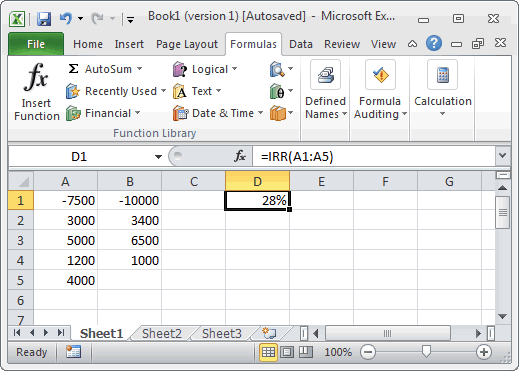Excel uses three different functions to determine IRR. These are IRR, XIRR, and MIRR. To use the formulas, simply select the “accounting” drop-down menu shown at the top of your screen and search for the formula that you want to use. Excel will then prompt you to enter in the necessary values and generate a calculation. The Internal Rate of Return (IRR) is an investment appraisal tool that helps us evaluate if we should invest in a project. Specifically, the IRR is the point at which the Net Present Value (NPV) is equal to zero. In other words, it’s a ‘discount rate’ that gives us a 0 NPV. Intuitively, there are 2 interpretations of the Internal Rate of.
- Irr To Work In Excel Sheet
- Irr Does Not Work In Excel
- How To Work Out Irr In Excel
- Using Irr Function In Excel
MIRR Function
XIRR Function
Irr To Work In Excel Sheet
The Internal Rate of Return (IRR) provides an indication of the profitability of an investment and therefore, is commonly used in business, when choosing between investments.
This measurement uses a series of cash flows (an initial investment, along with the net income) over a number of periods, to calculate the compounded return, assuming the Net Present Value of the investment is zero.
The value of the IRR is calculated as the value of r that satisfies the following equation:
Irr Does Not Work In Excel
where the series of cash flows provide the values for Cn and N is the number of periods over which the returns have been made.
 For a full explanation of the IRR, see the Wikipedia Internal Rate of Return page
For a full explanation of the IRR, see the Wikipedia Internal Rate of Return pageFunction Description
The Excel IRR function returns the Internal Rate of Return for a supplied series of periodic cash flows (i.e. an initial investment value and a series of net income values).
The syntax of the function is:
Where the arguments are as follows:
| values | - | An array of values (or a reference to a range of cells containing values) representing the series of cash flows (investment and net income values). This must include at least one negative value (representing outgoing payment) and at least one positive value (representing income). |
| [guess] | - | An initial guess at what the IRR might be. This is an optional argument, which, if omitted, takes on the default value of 0.1 (=10%). (Note: This is only a value for Excel to start off working with - Excel then uses an iterative procedure to converge to the IRR). |
Irr Function Example
In the spreadsheet below, an initial investment of $100 is shown in cell B1 and the net income over the next 5 years is shown in cells B2-B6.
The IRR function in cell C2 shows the calculation of the Internal Rate of Return after 3 years and the function in cell C4 shows the Internal Rate of Return after 5 years.
How To Work Out Irr In Excel
Formula:
|
|
Note that, in the above example, the initial investment is a negative value, as this is an outgoing payment, and the income payments are represented by positive values.
For further information and examples of the Excel Irr function, see the Microsoft Office website.
Irr Function Error
If you get an error from the Excel Irr function, this is likely to be the #NUM! error:
| #NUM! | - | Occurs if either:
|
Using Irr Function In Excel
Return to the List of All Built-In Excel Functions